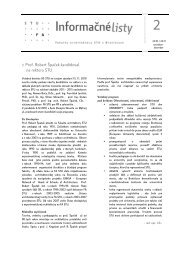ALFA 3-4/2005 - Fakulta architektúry STU
ALFA 3-4/2005 - Fakulta architektúry STU
ALFA 3-4/2005 - Fakulta architektúry STU
You also want an ePaper? Increase the reach of your titles
YUMPU automatically turns print PDFs into web optimized ePapers that Google loves.
Ročník 9<br />
3-4 / <strong>2005</strong> ARCHITEKTONICKÉ LISTY FA <strong>STU</strong><br />
In 1981 the Memphis design studio was founded. Like Studio<br />
Alchimia, Memphis had created furniture that ran against<br />
the accepted principles of design and culture. Borrowing<br />
ornamental details from previous styles, Memphis successfully<br />
popularized anti-design and helped to its general acceptance<br />
within the furniture industry's mainstream.<br />
Based on economic boom and the failure of Modernism, Postmodernism<br />
emerged in the 1980s. Post-modern furniture<br />
designers had viewed styling rather than functionalism in order<br />
of importance. But unlike that of the Pop era, post-modern<br />
furniture is characteristic by the use of expensive materials and<br />
a strong construction what makes it percieved as longlasting and<br />
durable.A new visual language had been created but at<br />
the expense of any eal meaning or value to the consumer. In the<br />
mid 1980s, the pluralism in design started to be accepted. General<br />
economic prosperity caused an ever greater stylistic<br />
diversification in the furniture design and decorative arts.<br />
Designers started to work outside of the industry so they could<br />
expressed more spontaneous creativity, produce ever more<br />
fanciful chair designs. In this period of relative prosperity,<br />
specialized furniture galleries were established to exhibit these<br />
experimental and challenging rdesigns.<br />
Another part of avant-garde designers who were working within<br />
the industry, continually produced new chair designs to satisfy<br />
the public's desire for novelty during the 1980s. Like the 1960s,<br />
this was the decade when furniture design had followed fashion<br />
rather than the quest for solutions to real needs.<br />
The beginning of the 1990s is characteristic by new<br />
environmentally orientated approach to the chair design. Philippe<br />
Starck's “Louis 20 chair” (1992) is the example of an innovative<br />
construction of recyclable materials. Another example of using<br />
recycable materials is the Alfred Homann's highly rational<br />
“Ensemble chair” for construction which he used newly developed<br />
recyclable plastic. Further to the environmental concerns of today,<br />
these “recyclable” designs are admirable. But in the longer term,<br />
ecological requirement would be better when simply producing<br />
less last longer, following the quote of Marcel Breuer: “ A peace<br />
of furniture, and above all the chair, is not an arbitrary<br />
composition: it is a necessary component of our environment…<br />
the outward expression of our everyday needs, it must be able to<br />
serve both those needs that remain constant and those which<br />
vary. This variation is possible only if the very simplest and most<br />
straightforward pieces are used, otherwise changing will mean<br />
buying new pieces. Let our dwelling have no particular “style”, but<br />
only the imprint of the owner's character.” (P. and Ch. Fiell, 1993)<br />
- 46 -<br />
The above briefly stated shortview of the chair in the 20 th Century<br />
clearly shows a significant influence of the social and<br />
societalstatus of the human society on the design development.<br />
In the way of life, as well as in the material base, it had become<br />
significant changes during this Century. The possibilities, better<br />
said the needs, of people had changed by radical means.<br />
The primary impulse of such whole development has been<br />
the technics. Architects and designers were among the first who<br />
were influenced by the technical products. Searching the unity<br />
between architecture and its the inner space, architects became<br />
the co-founders of the modern furniture and the chair design<br />
as well. Their dissatisfaction with possibilities given by that time<br />
and the offer of the interior furnishing was the moving force<br />
of the progressive development. The 20 th Century is characterized<br />
by the liberating of architecture and also the interior design from<br />
the historical period-style influences. In the forefront it gets<br />
“the call for new design”, that will be reachable to everyone. With<br />
the ambition to fulfill such effort, modernism is the main style<br />
or rather said movement. It is, although, in the last quarter<br />
“beaten” by plural views, without unified style classification. From<br />
the perspective of relationship between the chair and other interior<br />
design and furniture, the unified development is characterized for<br />
the first half century, while on the other hand, in the second half<br />
of the century, has such “unified” development divided. Therefore,<br />
the chair has come into a contrast position against the rest of<br />
the interior.<br />
Except the mentioned social and societal influence, the material<br />
base had an enormous influence on the development of the chair.<br />
With every new material within the whole century, the chair design<br />
form was changing rapidly. It is interesting that many projects that<br />
looked like a utopia at the time of its rise, but later with new<br />
materials and technical possibilities became a common reality.<br />
Therefore from such a perspective, there is certainly a lot to look<br />
for the moment when the vision of Marcel Breuer will be fulfilled.<br />
He has formulated an idea believing that once in the future we will<br />
be able to sit on “an invisible column of compressed air” ...<br />
(M. Lamarova, 1982).<br />
Literature<br />
1. FIELL, P. - FIELL, Ch.: Modern Chairs. Taschen, 1993. 160 s.<br />
ISBN 3-8228-2027-X.<br />
2. LAMAROVÁ, Milena: Židle 20. stoleti.Praha :<br />
Uměleckoprumyslové muzeum, 1982.<br />
3. VEGESACK, A. von - DUMAS, P. - SCHWARTZ-CLAUSS, M.:<br />
100 Masterpieces from Vitra Design Museum Collection. VDM<br />
Weil am Rhein, 1996. 270 s. - ISBN 3-9804070-3-9.

















